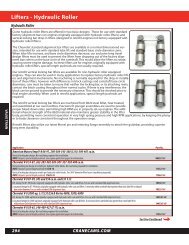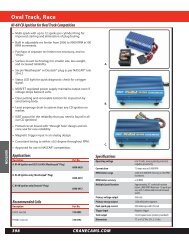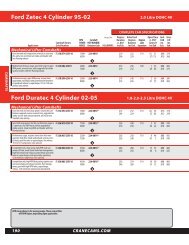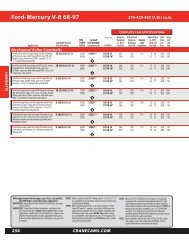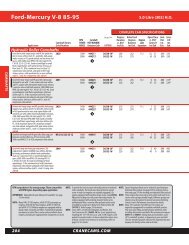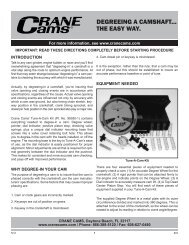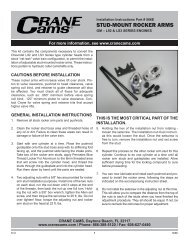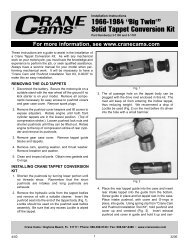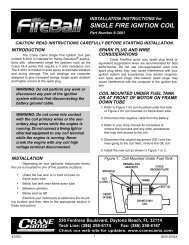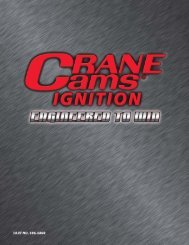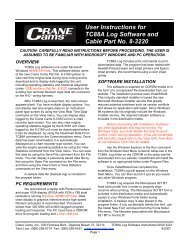2011 - Crane Cams
2011 - Crane Cams
2011 - Crane Cams
You also want an ePaper? Increase the reach of your titles
YUMPU automatically turns print PDFs into web optimized ePapers that Google loves.
CAMSHAFTS<br />
Chrysler Big Block V8 Tech Tips & Notes<br />
1958-1978 350-361-383-400-413-426-440<br />
B & RB V8<br />
The B and RB Big Block Chrysler engines vary primarily due<br />
to cylinder block deck height differences. Intake manifolds,<br />
distributor housings, and pushrod lengths are noticeable<br />
changes from one to the other. The B (Low Block) engines<br />
are 350-361-383-400- (1962) 413, while RB (High Block)<br />
engines are 413-426-400 cu.in. Characterized by inline lifter<br />
bores in the block, inline valves in the cylinder heads, 1.5:1<br />
ratio shaft mounted rocker arms, and a front mounted distributor,<br />
these engines were used throughout Chrysler’s<br />
product lines for over two decades. Be aware that there are<br />
reverse rotation marine, and also gear drive cam industrial<br />
versions of these engines, that require unique camshafts.<br />
Early cylinder heads had removable rocker pedestals for<br />
the rocker shafts, as did the 1960’s performance engines<br />
(Stage II, Stage III, Max Wedge, etc., which also featured<br />
adjustable rocker arms and mechanical lifter camshafts),<br />
while later heads have integral shaft stands.<br />
From 1958 to 1969, all camshafts used a single bolt to<br />
retain the cam sprocket. These have been the <strong>Crane</strong> 64 prefix<br />
camshafts, with hydraulic and mechanical flat faced lifter<br />
grinds offered. In 1970, the 440 Six Pack engines were<br />
upgraded by having a three bolt configuration camshaft<br />
installed. These are our 68 prefix items, which include<br />
hydraulic, mechanical, retrofit hydraulic roller, and mechanical<br />
roller camshafts and components. The single bolt and<br />
three bolt camshafts can be interchanged among these<br />
engines, providing the appropriate timing set is used. Due<br />
to their superior reliability, we will now be offering only<br />
the 68 prefix three bolt camshafts for their engines.<br />
The Chrysler Hemi 426 camshafts will also physically fit<br />
into the B engines, but due to their different lobe layout,<br />
only four cylinders would function properly.<br />
Our offerings include retrofit 8620 steel billet hydraulic<br />
roller camshafts and steel billet roller lifters to provide an<br />
excellent torque and power band increase. The lifters are a<br />
drop in type (no block machining, or lifter bore sleeving<br />
required), having a vertical locking bar to prevent rotation.<br />
Special pushrods are required due to the increased height<br />
of the lifters.<br />
Our steel billet mechanical roller camshafts are available in<br />
standard firing order (1-8-4-3-6-5-7-2) and SFO (1-8-7-3-6-5-<br />
4-2) firing orders. Roller camshafts for the Chrysler Mega<br />
blocks with 47 degree lifter bank angles, and other aftermarket<br />
blocks having 48 degree lifter bank angles are also<br />
available. Roller camshafts with 2.125” diameter journals<br />
can be custom ordered. Engines equipped with Koffel B1<br />
cylinder heads will require grooving the fourth camshaft<br />
bearing journal for proper upper end lubrication, optional<br />
labor number 98088 accomplishes this. All of our roller lifters<br />
are designed to drop into the block, with no machining<br />
or lifter bore sleeving required.<br />
Early raised cam Chrysler Mega blocks had very tall lifter<br />
bores and a 47 degree lifter bore bank angle, so part number<br />
66554-16 roller lifters (with the pushrod seats and<br />
168<br />
CRANECAMS.COM<br />
guidebars raised .400”) can be used to avoid additional<br />
block machining. Special camshafts are also required for the<br />
change in lifter bank angle, so be certain of what you have<br />
before ordering.<br />
Aftermarket cylinder heads may require different rocker<br />
arms, shafts, pushrods, valve springs, retainers, locks, etc,<br />
than standard. Make sure of exactly what you need before<br />
ordering additional components.<br />
1966-1971 426 Hemi V8<br />
The famed 426 Hemi is related to the RB V8. One primary<br />
change to the cylinder block includes additional head bolt<br />
bosses for the Hemi head’s internal attaching bolts. These<br />
cylinder heads utilize the classic Chrysler double shaft system<br />
for the intake and exhaust rockers. Standard rocker<br />
ratios are 1.57:1 intake, and 1.52:1 exhaust. Lifter bores are<br />
inline, inclined at a 45 degree bank angle. These engines are<br />
indicated by our 66 prefix.<br />
There were also 1964 –1965 426 Hemi 426 engines that<br />
had single bolt camshafts. We recommend using the later<br />
three bolt configuration camshafts and timing sets in these<br />
engines (no other modifications required) for increased reliability.<br />
The Chrysler B/RB camshafts will physically fit into<br />
the Hemi engines, but due to their different lobe layout,<br />
only four cylinders will function properly.<br />
The currently available aftermarket cylinder blocks have<br />
either standard or raised camshaft locations. Most of the<br />
raised camshaft blocks have the lifter bores changed to a 48<br />
degree lifter bank angle, for better pushrod geometry.<br />
Special camshafts are required to maintain proper cam timing<br />
for each side of the engine. Early raised cam Chrysler<br />
Mega blocks had very tall lifter bores and a 50 degree lifter<br />
bore bank angle, so part number 66554-16 roller lifters<br />
(with the pushrod seats and guidebars raised .400”) can be<br />
used to avoid additional block machining. Special camshafts<br />
are also required for this unique change in lifter bank<br />
angle. Some replacement iron blocks may also have tall lifter<br />
bores. Check your lifter guidebar to block clearance<br />
before final engine assembly in the event that modifications<br />
are required.<br />
The aftermarket blocks may also have relocated lifter bore<br />
spacing. While the standard lifter centerline spacing is<br />
1.812”, there are also popular “Spread .100” (1.900”) and<br />
“Spread .200” (2.000”) configurations. Be sure of your spacing<br />
when ordering roller lifters so that you don’t exceed the<br />
travel capabilities of the guidebar.<br />
We offer hydraulic, retrofit hydraulic roller, mechanical, and<br />
mechanical roller camshafts and components for these<br />
engines. When installing our hydraulic roller camshafts and<br />
retrofit lifters, machining will be required on the block and<br />
cylinder heads to provide clearance for the pushrods. This is<br />
due to the increased pushrod seat height on the hydraulic<br />
roller lifters, changing the angle of the pushrods. Our roller<br />
lifters are designed to drop into the block, with no machining<br />
or lifter bore sleeving required.



